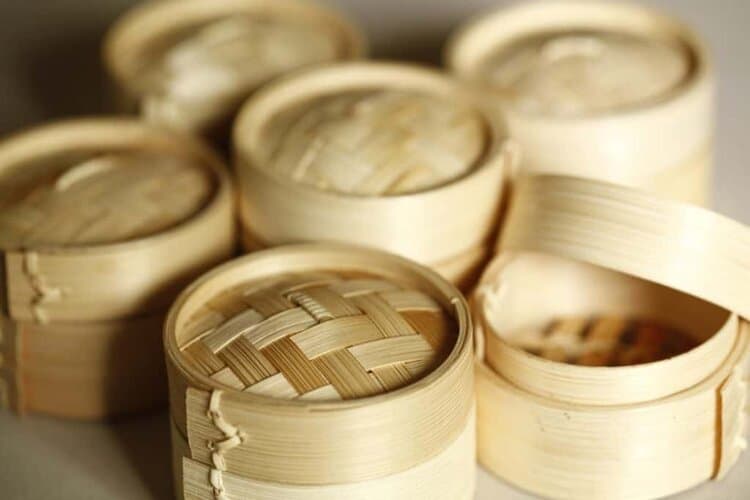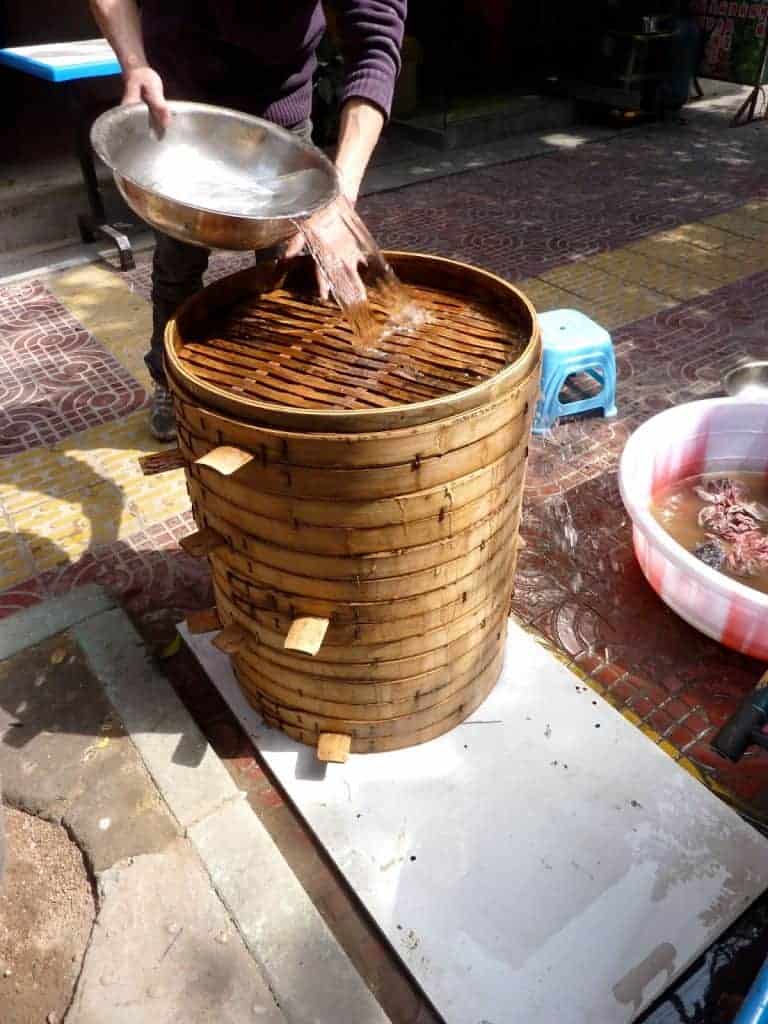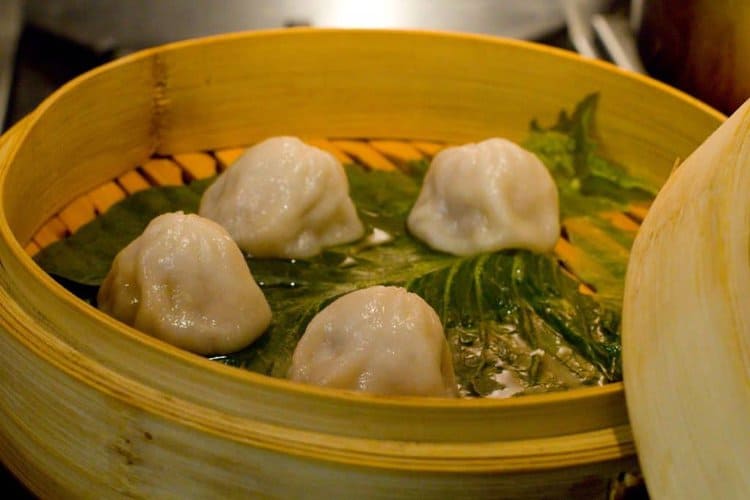Scrub your bamboo steamer using a nylon scrubber and a solution of white vinegar and water in a 1:2 ratio. Then, rinse under warm or hot water and let it air dry.

You can clean your bamboo steamer in different ways.
One of the easiest ways is to rinse or soak your bamboo steamer in the sink. Some people even clean their bamboo steamer in the dishwasher.
You shouldn’t use rough steel wool or other cleaning tools when cleaning a bamboo steamer as they can cause damage. It’s best to read your instruction manual for tips on how to clean your bamboo steamer without causing damage.
If you no longer have your user manual, we’ll provide a quick guide on cleaning your bamboo steamer safely, so let’s dive right in.
How to Clean Bamboo Steamer: 10 Easy Steps
You should clean your bamboo steamer regularly and properly to prevent mold and bacteria growth. The following steps can help you clean your bamboo steamer easily and successfully, so take a look.
Step 1: Rinse With Warm, Soapy Water
Place a large clean pot in your sink and fill it with warm water. Then, add drops of liquid soap into the water and mix until you get a foam.
Rinse your bamboo steamer in the water, then remove it and let it air-dry. Note that bamboo is a very porous wood and might take in detergent or liquid soap mixed into the water used to clean it.
This could cause the steamer to discharge a soapy stench during constant use, so check the manufacturer’s user manual before cleaning with soapy water.
Step 2: Soak Your Bamboo Steamer in Hot Water
If rinsing with warm soapy water doesn’t do the trick, soaking in hot water might. So, fill a large pot with hot water and place your bamboo steamer inside.
Let it soak overnight or at least a few hours. The next day or after a few hours, take off the bamboo steamer from the pot and let it air dry.
Keep in mind that some bamboo steamers aren’t made to handle hot-water soaking, so consult your user manual first.
Step 3: Rinse Your Bamboo Steamer Under Plain Water
You can either rinse your bamboo steamer under hot or warm water. Simply turn the faucet on and place your bamboo steamer underneath it.

As the water goes over the surface of your bamboo steamer, flip it over in your hand and let both the outer and inner surfaces get rinsed, then let it air-dry before using it again.
Step 4: If Water Doesn’t Work, Use A Nylon Scrubber
If you see any caked-on food, use a nylon scrubber to remove them. Scrub any area of the bamboo steamer that seems dirty, and then rinse under plain water.
Avoid steel wool or any other abrasive kitchen tool to clean this type of appliance as it can cause damage.
Step 5: Use Black Tea
If your bamboo steamer looks old and dirty, use a black tea bag to clean and refresh the overall appearance of your appliance. The tannic acid in black tea will do a great job cleaning your kitchen appliance.
Simply soak your bamboo steamer in black tea for a couple of minutes, then gently rub the tea bag over the surface of your steamer.
Avoid using too much force. Otherwise, the fragile tea bag will split apart and leave a residue within your bamboo steamer.
Step 6: Use Lemon for Deodorizing Purposes
If you cooked fish in your bamboo steamer, you could easily remove the pungent odor by rubbing a lemon across the surface of your appliance.
Simply cut a lemon into 4 equally sized pieces and rub one piece across the surface gently. Use the rest of the lemon pieces if you feel necessary.
Step 7: Try the Dishwasher
If you believe no manual method can help you clean your bamboo steamer properly, use the dishwasher with caution.
Keep in mind that some bamboo steamers can handle high pressures of hot water, while others can’t. So, make sure yours isn’t designed for manual washing only.
Check your user manual for detailed cleaning instructions.
If your steamer allows heavy-duty cleaning in your dishwasher, give it a try with a specific type of detergent that your manual suggests or without any detergent if you can’t find any recommendations in the user manual.
Then, let it air-dry before using it again.
Step 8: Coat Your Bamboo Steamer
Make sure you coat your appliance after each wash to prevent it from drying. Simply take a piece of paper towel and soak it in cooking oil.
Run the oiled paper towel over the outer and inner surfaces of your appliance. You can use any type of cooking oil, including olive oil, vegetable oil, etc.
Step 9: Soak Your Bamboo Steamer Before Each Use
It’s highly suggested to soak your bamboo steamer before each use to prevent the bamboo from burning during the cooking process.
Soak it for around 15-20 minutes but note that some bamboo steamers aren’t suitable for soaking. It can damage their design, so consult your manufacturer’s manual for instructions regarding whether soaking before use is suggested.
Step 10: Don’t Place Food Directly on Your Bamboo Steamer
You can make the cleaning process much easier if you don’t place food directly on your bamboo steamer.

Instead, use parchment paper that matches the size of your appliance on which you can put the food you want to steam without any mess. You can also use a heatproof plate on the lattice, then place the food you want to steam on the plate.
The paper or plate should have a border of open space around the perimeter so that the steam can rise and cover the food you’re trying to steam.
How to Deodorize A Bamboo Steamer Successfully?
Bamboo is a porous wood, and since bamboo steamers consist of bamboo, they’re susceptible to absorbing the smell of some of the food you steam in them, but don’t worry, as you can deodorize your steamer with either of the following methods.
Method 1: Vinegar and Water
Make a cleaning solution of white vinegar and water in a 1:2 ratio.
Using a soft brush such as a pastry brush, gently apply the solution over the inside parts of your bamboo steamer. Finally, rinse under hot water and let it air-dry.
Method 2: Lemon and Water
If there’s still a lingering smell, perhaps water and lemon can help.
Bring a pot of water to a gentle boil and place your bamboo steamer over it. Then, cut a lemon in half and add both pieces to the bamboo steamer.
Add the lid in place and let the lemon-infused steam penetrate every part of your appliance for about 15 minutes.
After 15 minutes, remove the appliance from the pan and set it aside to cool.
Once it’s cool to the touch, remove the lemon pieces and rinse the steamer in hot water. Then, let it air-dry and enjoy a smell-free bamboo steamer.
How to Deal With Mold in A Bamboo Steamer?
You can’t let mold develop in your bamboo steamer.
It’s a cooking appliance, and mold shouldn’t be anywhere near your food, but worry not, as you can remove it with white vinegar or lemon oil.
You can gently scrub your bamboo steamer with a nylon brush and lemon oil or vinegar-water solution in a 1:2 ratio.
Once you’re done cleaning, rinse your appliance and let it air-dry.
How to Minimize the Cleaning of A Bamboo Steamer?
Prevention is always better than cure, so take better care of your bamboo steamer after each use. That’s how you can minimize the future cleaning not only of your steamers but other kitchen appliances too.
Prevent Food from Sticking
The best way to keep food from sticking to the bottom of your bamboo steamer is to line the inside of the basket with a sheet of parchment paper, bamboo steamer liner, or a heatproof plate.
If you don’t have these things on hand, you can use cabbage or lettuce leaves instead.
Store Your Bamboo Steamer Properly

Never store your bamboo steamer in plastic containers. Instead, keep it in the open to air-dry after each use.
Otherwise, any moisture that’s still inside the bamboo steamer can encourage mold and mildew growth.
When you purchase a new bamboo steamer, clean it before you use it as any residue remaining after the manufacturing process will likely have picked up dirt and dust in storage.
FAQs on How to Clean Bamboo Steamer
Why do I need to clean my bamboo steamer?
A bamboo steamer uses heat and steam to cook the food which can make food stick to the inside of the steamer. And if not cleaned, it can cause bacteria growth and unpleasant odors.
Can I use aluminum paper to line up the inside?
You can use aluminum paper instead of parchment paper or bamboo steamer liner, but make sure you poke holes in it so the steam can get to the food.
